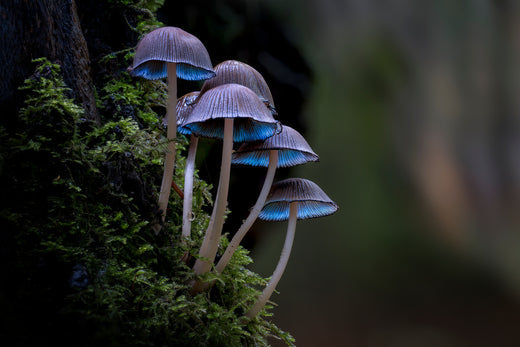The Intelligent Life of Fungi

Share
Contrary to popular belief, fungi aren’t just mushrooms. Fungi are a vast kingdom of microorganisms that include mushrooms, mould and yeast, and surprisingly, they are neither plants nor animals.
Mushrooms are the fleshy, fruiting bodies of fungi above the ground, which are actually the reproductive parts of the fungi! They are a kingdom of life with hundreds of thousands of species, 14 of those being functional mushrooms. Functional mushrooms contain active compounds beyond their nutritional composition; scientists have studied them for their potential health-giving properties for the human body and mind.
Fungi have a long-standing evolutionary history. They are known to be one of the oldest living organisms, literally as old as dust… dating back to 1 billion years! They were the earliest multi-organism life forms to march from the ocean to colonise the land, becoming metabolic wizards, changing one substance to another. Most notably breaking down rock into soil. They do this by secreting enzymes that break down complex organic compounds into simpler molecules, which they can absorb as nutrients. This helps recycle nutrients back into the ecosystem, making them available for other living organisms to use. Fungi are critical to Earth’s carbon cycle, as they are natural decomposers of organic materials such as fallen leaves, wood, and other organic materials.(1) If it weren’t for fungi, we would all suffocate in miles of dead organic matter!

Fungi is a kingdom with approximately 3 million species, so vast that they out-number plants 6-1. Under this kingdom sits the functional mushrooms, which can be traced back thousands of years of ancestral uses by ancient cultures who used them to support their overall well-being. Egyptians, Greeks, and Romans recognised the value of functional mushrooms for their nutritional and health-aiding properties. In China, functional mushrooms were revered for their health benefits and were considered the "elixir of life" by Taoist alchemists.
In recent years, research has re-ignited the importance of fungi and their contribution to the world and their significance for the future well-being of our planet. They are a crucial part of our ecosystem…keep reading, and you will see that without fungi, we’d all cease to exist.
THE WOOD WIDE WEB OF FUNGI
Fungi have tiny thread-like structures called hyphae, which expand to form the mycelium network. This network is microscopic, but the largest living organism ever known is an Armillaria fungus, which covers almost 10 square kilometres (3.7 square miles) in Oregon.(2)
Mycelium is a sophisticated communication network, allowing fungi to interact with one another and connect and cooperate with other organisms. Fungi form symbiotic relationships with plant roots. In these mutually beneficial partnerships, fungi aid in nutrient uptake for plants, while the plants provide sugars as nourishment for the fungi.
What’s more interesting is that fungi use chemical signalling to warn neighbouring individuals of potential threats, such as herbivores or adverse conditions. This early-warning system enables the fungal community to respond collectively to challenges, enhancing their overall survival chances.

ADAPTING AND SURVIVING IN VARIOUS CIRCUMSTANCES
Fungi demonstrate intelligence in their extraordinary ability to adapt to different environments. Through a process called chemotaxis, they can detect and move toward specific chemicals, allowing them to navigate and colonise new territories.
Fungi also adapt to changing environmental conditions. They can adjust their growth patterns and reproductive strategies accordingly.
Some fungi, like Chaga, a functional mushroom, grow at a prolonged rate. It can take years to grow on birch trees in cold, harsh environments; some will take up to 24 years to mature. It has a hardwood exterior, which allows it to endure extreme conditions.
Lion’s Mane is a functional mushroom that, like many other functional mushrooms, thrives in damp, dark conditions, and its main menu of choice is dead organic matter, like a fallen log.
Tremella is a jelly-like translucent functional mushroom made up of branching frond-like parts supported by a central base and is generally found on fallen branches of broad-leaved trees.
Some fungi can remain dormant for extended periods, waiting for favourable conditions before resuming their life cycle.
PROBLEMS? NOT FOR FUNGI
Fungi are great at solving problems; for instance, they can alter their growth directions when they encounter an obstacle, and they find alternative paths to find nutrients.
Fungi can adapt their enzymatic production to break down complex substances they encounter.
And get this: Fungi have survived five world extinctions, and for every extinction, fungi have re-inherited this planet, bringing colour, nutrients, medicine, and food back into our planet once more.
DEFENDING AGAINST HARM AND DANGER
As with anything in nature, danger isn’t far away, from animals to other organisms that may pose a threat. Fungi have developed different strategies to defend against potential harm. Some fungi have a chemical defence.(3) These compounds can be toxic to animals and drive them away from the fungus. Others deploy physical barriers, such as reinforced cell walls, to safeguard against potential attacks.
NATURE’S INTELLIGENCE - MEMORISING AND LEARNING
Studies have shown that most organisms respond better to severe stress (triggering stress) if they have experienced milder stress (priming stress) beforehand.(4) Fungi are no exception, having shown capabilities of spatial recognition, learning and short-term memory.(5)
Asking how long organisms can remember a priming event is an interesting question. Andrade-Linares, Veresoglou and Rillig, three German microbial ecologists, studied priming in fungi by temperature stress in filamentous fungi. Fungal colonies of 19 different filamentous fungi were tested. The mycelia that were incubated at elevated temperatures grew more swiftly after they were exposed to a second, more severe heat shock than controls that did not experience the initial heat shock (the priming stress). This suggests that compensatory heat shock mechanisms adopted during the first period of stress are activated immediately when the second shock occurs, thereby revealing that the fungus can remember the first stressful experience for up to 12 h.(6)

In the captivating world of fungi and functional mushrooms, we've delved deep into the intricate and often mysterious realm of these remarkable organisms, from their ancient use in traditional medicine to their intriguing survival skills. Fungi are a life form like no other, and they are around to contribute to our Earth and our existence in one way or another. The story of fungi and functional mushrooms is an ongoing saga of discovery and awe, a reminder that in the natural world, there are still countless mysteries waiting to be unveiled. As we continue our journey, let's embrace these fungi as our allies on the path to well-being and as a source of inspiration to deepen our connection with the wonders of the natural world.
REFERENCES
- Lustenhouwer, N., Maynard, D.S., Bradford, M.A., Lindner, D.L., Oberle, B., Zanne, A.E., and Crowther, T.W. (2020) ‘A Trait-Based Understanding of Wood Decomposition by Fungi’. Proc Natl Acad Sci U S A. 117 (21), pp.11551-11558. doi: 10.1073/pnas.1909166117.
- USDA (2008). ‘The Malheur National Forest Location of the World’s Largest Living Organism [The Humongous Fungus]’ Available at: https://www.fs.usda.gov/Internet/FSE_DOCUMENTS/fsbdev3_033146.pdf (Accessed: 30 August 2023).
- Milton T Drott. (2021) ‘Fungi: Sex and Self Defense’ eLife. 10. https://doi.org/10.7554/eLife.73723.
- D.R. Andrade-Linares, S.D. Veresoglou, M.C. Rillig. (2016). ‘Temperature priming and memory in soil filamentous fungi’. Fungal Ecol., 21 (2016), pp. 10-15.
- Money,N.P. (2021). ‘Hyphal and Mycelial Consciousness: The Concept of the Fungal Mind’. Fungal Biology. 125(4), pp.257-259 https://doi.org/10.1016/j.funbio.2021.02.001.
- Andrade-Linares et al.











































